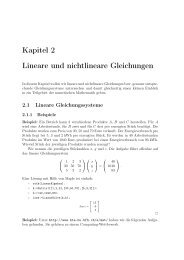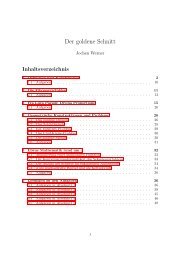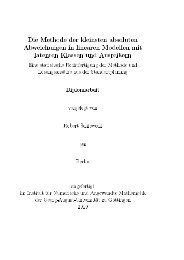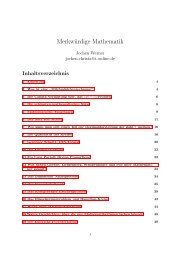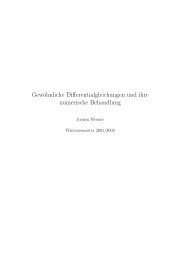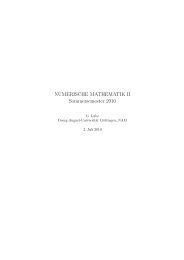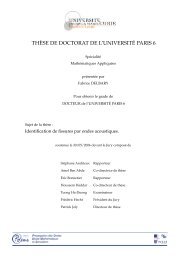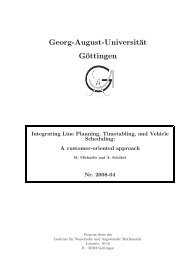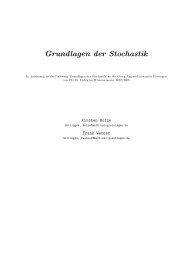BAIL 2006 Book of Abstracts - Institut für Numerische und ...
BAIL 2006 Book of Abstracts - Institut für Numerische und ...
BAIL 2006 Book of Abstracts - Institut für Numerische und ...
Create successful ePaper yourself
Turn your PDF publications into a flip-book with our unique Google optimized e-Paper software.
M.H. BUSCHMANN, M. GAD-EL-HAK: Turbulent Bo<strong>und</strong>ary Layers: Reality and<br />
Myth<br />
✬<br />
✫<br />
into the Navier-Stokes equations and taking the limit Re → ∞, leads to Prandtl’s bo<strong>und</strong>ary layer<br />
equations<br />
The bo<strong>und</strong>ary conditions are<br />
uu x + vu y = ! p x + u yy ;<br />
y = 0 :<br />
u = v = 0 and<br />
0 = p y ;<br />
y ! " :<br />
The task is now to find physically appropriate solution for eqn. (3).<br />
ux + v = 0 (3)<br />
y<br />
u ! U e x ( ) (4)<br />
What goals do we have when solving eqn. (3)? One <strong>of</strong> the main objectives is to find self-similar<br />
solutions. Bo<strong>und</strong>ary layers are self-similar when normalization can be fo<strong>und</strong> so that data <strong>of</strong><br />
different physical realizations (e.g., experiments in different wind tunnels, pr<strong>of</strong>iles at different<br />
downstream positions within one experiment) can be collapsed within one single curve.<br />
Examples are the mean velocity pr<strong>of</strong>iles <strong>of</strong> the Blasius’ laminar zero-pressure-gradient bo<strong>und</strong>ary<br />
layer and the fully-developed turbulent flow in pipes.<br />
y<br />
u( x, y )<br />
u( x, y )<br />
x 1<br />
3 x<br />
x 2<br />
Which physical problems do we face when solving eqn. (3)? We neither know if for a certain<br />
type <strong>of</strong> wall-bo<strong>und</strong>ed flow a transformation as searched for in the first question exists in general,<br />
nor do we know what the transformation parameters are. The physically appropriate<br />
transformation is a non-dimensionalization that is much more than simply changing the<br />
coordinates. The crucial issue is top choose the scaling based on the physics <strong>of</strong> the problem. At a<br />
minimum, the scale basis has to satisfy two criteria. It should consist <strong>of</strong> characteristic<br />
parameters and represent problem-intrinsic scales. The fo<strong>und</strong>ation <strong>of</strong> dimensional analysis is the<br />
Π-theorem formulated by Buckingham. 2<br />
f ( x 1 ,x 2 ,...xn ) 0<br />
Here xi denote the n variables <strong>of</strong> the system having m dimensions and Δi are the non-dimensional<br />
similarity parameters <strong>of</strong> the problem.<br />
2 Buckingham, E., “On physically similar systems: illustrations <strong>of</strong> the use <strong>of</strong> dimensional equations,” Phys. Rev., 2.<br />
Ser., vol. 4, pp. 1119–1126, 1914.<br />
u( x, y )<br />
Π-theorem<br />
y<br />
!<br />
Find proper<br />
scaling parameters<br />
Δ and U<br />
= ( 1 2 n m)<br />
u( x, y)<br />
U<br />
F ! , ! ,... ! " = 0<br />
M. H. Buschmann & M. Gad-el-Hak, Abstract for <strong>BAIL</strong> <strong>2006</strong><br />
Speaker: BUSCHMANN, M.H. 33 <strong>BAIL</strong> <strong>2006</strong><br />
✩<br />
✪



